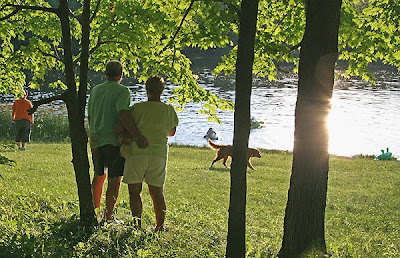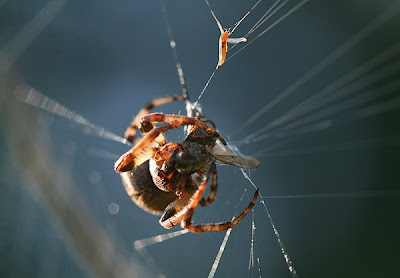I was following Sonn Hupp on her morning
 feeding chores at the Ohio Bird Sanctuary recently when a Mourning Dove plopped itself on her head as if to ask, “Where have you been?”
feeding chores at the Ohio Bird Sanctuary recently when a Mourning Dove plopped itself on her head as if to ask, “Where have you been?”But more likely it was an expression of avian gratitude from this very friendly bird.
Hupp cocked her head gently so as not to disturb the bird and smiled at the experience.
Like most staff and volunteers at the sanctuary Hupp fills many roles; her formal title being Youth Program Coordinator.
After disentangling herself from the friendly dove she went on to make two very young Carolina Wrens quite happy with a wiggly breakfast of meal worms.

This Screech Owl named “Bob”, partially retired, came to the center after his nesting tree fell and he was the only survivor. He already had been human imprinted—which is irreversible—so he could not be returned to the wild. His reddish color is one of two phases for these owls, depending on their habitat.
Earlier, I met founder and executive director Gail Laux as she opened for the morning and promptly was dealing with a messy floor caused by a recuperating and heavily bandaged Black Vulture named “Igor” which had been a little careless with its overnight toilet manners.
Laux started the sanctuary at her rural, family home in Bellville in 1988 and has been located at the expansive 52 acre Orewiler Road site adjacent to Boy Scout Camp Avery Hand since 1992.
While scout officials have been embroiled in a community controversy over their plans to sell the camp site, Laux is confident the sanctuary’s ongoing fundraiser toward the land contract purchase of their acreage will be successful.
Laux and her board also are eyeing the scout’s unused cafeteria facility for future sanctuary program growth and as a buffer zone should the neighboring scout camp ultimately be sold for residential development.
In 2007 the sanctuary received 143 birds in need of care. One noteworthy case involved a Merlin that was banded in Ontario Canada on its migration south then became entangled in razor wire at the Mansfield Correctional Facility.
That bird was treated at the center for three weeks before it was released to continue its southerly travels.
Often as many as 40 birds call the sanctuary their permanent home. They are unable to be released back into the wild.
For the first 10 years of its operation the sanctuary was primarily involved with birds of prey programs. That scope has broadened considerably. In 2007 the staff presented 218 school programs, did 10 special public displays, gave 62 programs to groups and clubs, hosted 29 field trips and held 27 days of Nature Camp.
They reached over 21,000 individuals during those 2007 activities.

Many of their display birds also are put to work; being bundled up and taken to off-site locations where they delight the program participants. New to their educational collection recently is a Green Heron now named “Reed” who arrived at the sanctuary after it fell from its nest and suffered a fracture.
A crow known as “Mr. Corvid” also has joined the traveling troupe. He is certainly a friendly critter, quick to squeeze his head through his enclosure and give a friendly nod to passers by.
A Barred Owl named “Homer” who was struck by a car, permanently damaging his vision, w
 ill replace another owl named “Apollo” in their outreach programming.
ill replace another owl named “Apollo” in their outreach programming.“Apollo” and his cohort the Screech Owl named “Bob” will be enjoying semi-retirement now that they are both over 13 years of age.
Photos of the Cast of Characters (from top right):
“Apollo” is a Barred Owl mentioned in the text.

“Bullet” is a Peregrine Falcon who arrived at OBS with an injured right eye and beak. He serves as an “Educational bird”.
“Target” is a Red Tailed Hawk who arrived 7 years ago with a fractured femur. It has the restful duty of being a “Display bird”.
“Ichabod” is a Turkey Vulture who was illegally hatched and seriously imprinted by
 humans. He is a very popular “Display bird” too. “Nobody steals the show like he does,” Laux smiled.
humans. He is a very popular “Display bird” too. “Nobody steals the show like he does,” Laux smiled.Here are a couple of ways you can help. A $25 annual, donation, for example, will get you their newsletter, invitations to special events and a 10% discount in the gift shop. For $50 you can Adopt-a-Bird which will net you a nicely customized certificate and photo of your very happy avian critter.
Lots more details are here: www.ohiobirdsanctuary.com














